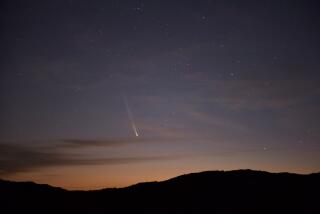Borrelly Has Scientists Rethinking Comet Theory
- Share via
The first clear and close-up photos ever taken of a comet have scientists rewriting much of what they thought they knew about the common and often dazzling objects that transit our solar system.
“It’s mind-boggling and stupendous,” said Laurence Soderblum, who led the team that captured images of the comet Borrelly about 137 million miles from Earth using NASA’s Deep Space 1 spacecraft. Comets, he said, “are far more complex than we ever imagined.”
Comets have long been thought of as relatively homogeneous objects that generate uniform clouds of dust and gas.
The new images contradict those beliefs. Borrelly’s 5-mile-long rocky core is far from uniform. It’s an object of rugged terrain that includes two mountainous peaks, smooth rolling plains and deep fractures. The core, or nucleus, of the comet is shaped something like an upside-down bowling pin. “It’s a very strange geometry,” Soderblum said.
Moreover, it is known that comets disrupt the energized particles that come from the sun and flow through space. But preliminary measurements from Deep Space 1 show that Borrelly disrupted this “solar wind” in a completely unexpected manner. The nucleus of the comet did not do the disrupting; the solar wind was disrupted by charged particles that came from the comet, but were only on one side of it.
“It’s as if a shock wave is not in front of a jet fighter, but a mile off to the side,” said David Young, a space physicist at the University of Michigan. “It’s in the wrong place. Period.”
Fascination with comets dates back to ancient times, when people treated the occasional visitations of mysterious “hairy stars” as omens. Scientists regard the icy clumps of rock and dust as pristine, frozen remnants of the material that made up the early solar system. Some researchers theorize that comets may have been responsible for carrying to Earth the water and organic materials necessary for life.
Comets “tell us where we came from and where we might be going,” Robert M. Nelson, the project scientist for Deep Space 1, said at a news conference Tuesday at NASA’s Jet Propulsion Laboratory in Pasadena.
Another puzzle from Borrelly is that the nucleus is much darker in some places than others. The entire object is covered with soot--but some of the soot is “dark, dark, dark, dark,” Soderblum said. Scientists are not sure why the areas look so different. The darker areas appear to be on top of the peaks and “are not just shadows,” Soderblum added.
The photos lend credence to the idea that comets are less like “dirty snowballs” than “snowy dirt balls.”
“This object is blacker than a charcoal briquette on the surface,” said Donald Yeomans, an expert on comets at JPL who was not directly involved with the mission.
The inside of the comet is likely to be mainly ice, he said, comparing the comet to a baked Alaska dessert--a frozen core surrounded by a crust of different material.
In addition, there is not just one jet of gas coming from the comet, but jets spewing in several directions. The largest jet is not uniform, but appears to be made up of at least three columns. And the jets spout from distinct parts of the comet, most notably the smooth plains, which appear to be eroding as material spews off.
“This is not a ho-hum picture,” Young said. “We’ve got some explaining to do.”
Scientists said Tuesday they were just beginning to analyze the photos and voluminous amounts of data gathered by the spacecraft. “All these ideas are still floating around in our heads,” said Daniel Boice, a member of the science team from the Southwest Research Institute in San Antonio.
The spacecraft that snapped the images, Deep Space 1, was not built to conduct any science and has far outlived its expected life span. It was launched in 1998 to spend a year testing exotic new technologies, including an engine propelled solely by ions and an artificial intelligence navigational system. But it has been nursed along and rescued once from complete failure by a band of JPL engineers led by Marc Rayman. Nearly emptied of gas, it made it to the comet on fumes.
“If this was a car, the fuel light would be on,” said Todd Barber, a JPL propulsion engineer.
Although he is still analyzing information coming from the spacecraft, Rayman said it appeared to survive the risky 36,900-mile trip through dangerous cometary debris unscathed. “The only thing unusual about the spacecraft,” he said, “is it has a big grin on it now.”
Images of the comet can be viewed at https://www.jpl.nasa.gov






